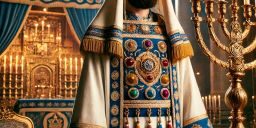From The Rabbi’s Study… Shabbat, March 7,8, 2025/7,8 Adar 5785
The torah portion continues with the description of the tabernacle begun in the preceding portion. It includes the ner tamid (eternal lamp) above the sanctuary ark. Aaron and his sons are appointed priests to manage the sacrifices offered in the sanctuary. A description of the priestly clothing, including the ephod, breastplate, robe, fringed tunic, headdress, and sash. Aaron’s ceremony of ordination as a priest, along with instructions for the slaughtering of offerings. The portion concludes with the directions for building an altar for burning incense before the ark.
What is the ner tamid? Many scholars believe the origin is found in the Torah portion: “You shall command the Israelites to bring pure olive oil beaten for the light, to cause a lamp to burn continually” (Exodus 27:20). The sages believed this light burned perpetually inside the tabernacle as a symbol, which was to be a “light unto the nations” (Isaiah 42:7). The ner tamid’s, eternal light is found in every synagogue and continues to hang before the holy ark, which symbolizes the permanence of the Torah and the radiance of the Jewish faith, which like the ner tamid is eternal.
Another symbolic piece of Jewish rituals from the ancient times was the Ketoret/ incense that were used in the tabernacle (Exodus 30:1). This fragrant smoke of burning incense at dawn and sunset was a natural symbol of one’s prayers ascending to heaven. The Book of Psalms says: “Let my prayer be set forth as incense before You” (Psalms 141:2). The sages point out that each of the letters of the Hebrew word, Ketoret/incense represents the quality associated with sincere prayer.
So why do the Jews not use Ketoret anymore? The Ketoret was used only in the Holy Temple of Jerusalem, and its sacrificial rituals, which could only be performed in that sacred space. Anyone studying Hebrew? If you are, then you know each Hebrew word has a shoresh/root consonant letters. Ketoret, root letters have many meanings. These are a few korban/offering,keter(Aramaic)/ bond and others are bringing a person closer to G-d, uplifting that individual from the mundane to sacred moments while praying in the Holy Temple. Keep in mind the individual brought a sacrifice for offerings to G-d for His blessings.
May each of us feel that special connection to G-d while praying. The type of feeling one has in living within the sacred moment. There are a myriad of ways one may express their feelings openly by their chanting rhythm, dance type movements or shukelling(Yiddish). G-d accepts all your prayers in all different languages and ways!
May we pray for peace in Israel and the release of all Hostages.
May we pray for peace in Ukraine and other places throughout the world.
Shabbat Shalom v’Am Ysrael Chai,
Rabbi Helene Ainbinder







